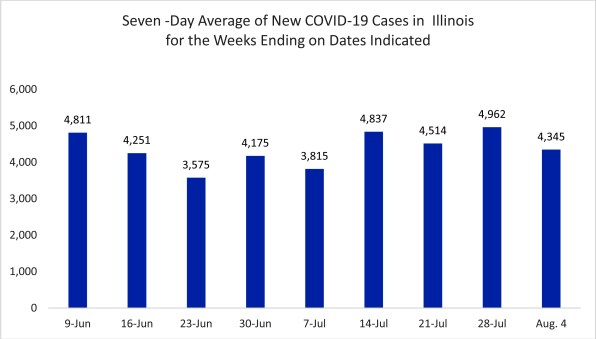Cook County, including Chicago, remained in the “high” community risk level. City officials say Evanston is in the “medium” risk level.
The number of new cases being reported is significantly lower than the actual number of new cases being contracted because many new cases are not being reported. [1] Some researchers estimate that the actual number of new cases is between six and ten times higher than the number being reported.
Trends of new cases in Illinois and Evanston
Illinois: On Aug. 4, the number of new cases in the state was 4,149.
The seven-day average of new cases in Illinois on Aug. 4 was 4,345, down from 4,962 on July 28, a12.4% decrease. The chart below shows the trend.
Evanston: Evanston reported there were 28 new COVID-19 cases of Evanston residents on Aug. 3. (Evanston is reporting COVID-19 data with a one-day delay.)
There was a total of 163 new COVID-19 cases of Evanston residents in the week ending Aug. 3, compared to 185 new cases in the week ending July 28, a decrease of 12%.
The chart below shows the trend.
No Evanstonians died due to COVID-19 during the week ending July 28. The number of deaths due to COVID-19 remains at 155.
Northwestern University. The latest data reported on NU’s website shows that between July 22 and July 28, there were 65 new COVID-19 cases of faculty, staff or students. Cases of Evanston residents are included in Evanston’s data for the relevant period, Ike Ogbo, Director of Evanston’s Department of Health and Human Services, told the RoundTable. NU will update its data tomorrow.
Cases per 100,000
The weekly number of new cases per 100,000 people in Illinois is 239 in the seven days ending Aug. 4.
As of Aug. 3, the weekly number of new cases per 100,000 people in Evanston was 220. As of Aug. 4, the number was 211 for Chicago, and 226 for Suburban Cook County. An accompanying chart shows the trend.
Hospitalizations
There were 1,416 hospitalizations in Illinois due to COVID-19 on Aug. 3, compared to 1,476 one week ago.
The chart below, prepared by the City of Evanston, shows the trends in hospitalizations due to COVID-19 at the closest two hospitals serving Evanston residents.
Cook County is in the high risk level, Evanston the medium
The CDC and IDPH look at the combination of three metrics to determine whether a community level of risk for COVID-19 is low, medium, or high. They are: 1) the total number of new COVID-19 cases per 100,000 people in the last 7 days; 2) the new COVID-19 hospital admissions per 100,000 in the last 7 days; and 3) the percent of staffed inpatient hospital beds occupied by COVID-19 patients. [2]
The City of Evanston reported this evening, Aug. 4, that Evanston is in the medium risk category. IDPH reported today that Cook County, including Chicago, is in the high risk category. Lake, DuPage, Will, Kane, and McHenry Counties are also in the high risk category.
While Evanston has more than 200 new cases per 100,000 people, the city reported this evening that Evanston has a 7-day total of 5.12 new hospital admissions per 100,000 people, and that it has 2.61% staffed inpatient hospital beds that are occupied by COVID patients (using a 7-day average).
The city has not said which hospitals or how many hospitals it is considering in making its analysis of community risk.
The CDC and IDPH recommend that people in a community with a “high” transmission rate should take the following precautions:
- “Wear a well-fitting mask indoors in public, regardless of vaccination status (including in K-12 schools and other indoor community settings)
- “If you are immunocompromised or high risk for severe disease: wear a mask or respirator that provides you with greater protection; consider avoiding non-essential indoor activities in public where you could be exposed; talk to your healthcare provider about whether you need to take other precautions (e.g., testing); have a plan for rapid testing if needed (e.g., having home tests or access to testing); talk to your healthcare provider about whether you are a candidate for treatments like oral antivirals, PrEP, and monoclonal antibodies
- “If you have household or social contact with someone at high risk for severe disease consider self-testing to detect infection before contact, and consider wearing a mask when indoors with them
- “Stay up to date with COVID-19 vaccines and boosters
- “Maintain improved ventilation throughout indoor spaces when possible
- “Follow CDC recommendations for isolation and quarantine, including getting tested if you are exposed to COVID-19 or have symptoms of COVID-19.”
FOOTNOTES
1/The City of Evanston says that the State, the County and the City do not have a mechanism to report, verify or track at home test results. Because a positive at home test is regarded as highly accurate, most people who test positive in an at home test do not get a second test outside the home that is reported to government officials. The number of new COVID-19 cases reported by IDPH and the City thus significantly understates the actual number of new cases that are contracted. Some studies estimate the cases are underestimated by 600% or more.
2/ CDC recommends the use of three indicators to measure COVID-19 Community Levels: 1) new COVID-19 cases per 100,000 population in the last 7 days; 2) new COVID-19 hospital admissions per 100,000 population in the last 7 days; and 3) the percent of staffed inpatient beds occupied by patients with confirmed COVID-19 (7-day average).
The chart below illustrates how these indicators are combined to determine whether COVID-19 Community Levels are low, medium, or high. The CDC provides many recommendations depending on whether the COVID-19 Community Level is low, medium, or high.

